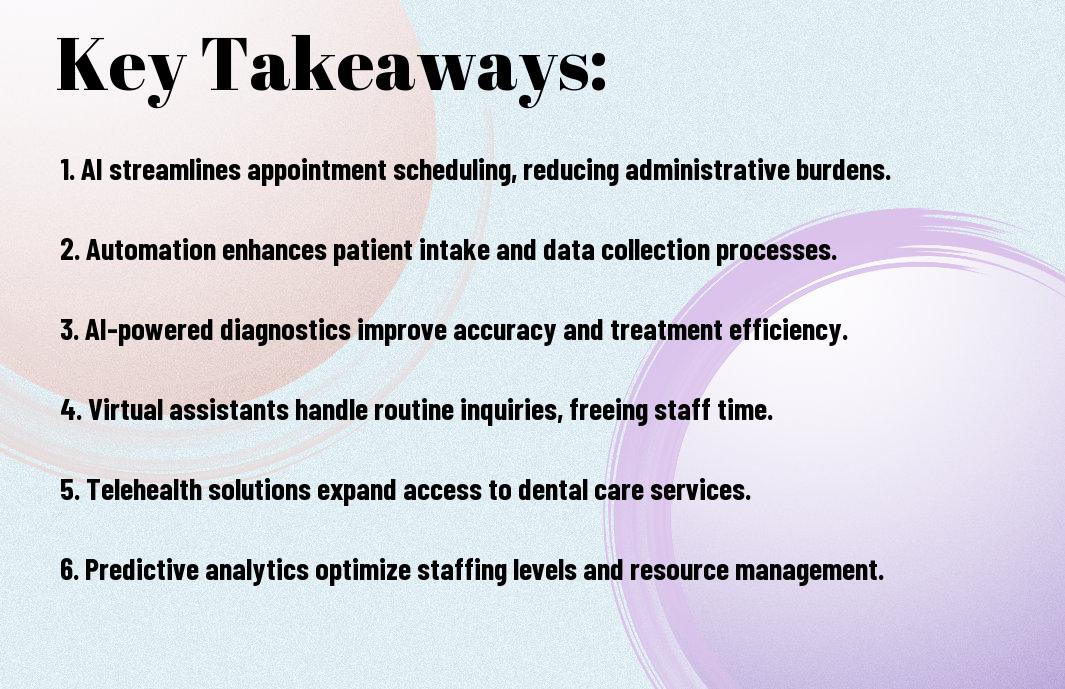How AI and Automation Can Help Combat Staffing Shortages in Dentistry
Dentistry is experiencing significant challenges due to severe staffing shortages, leaving many practices struggling to meet patient needs. In my exploration of this issue, I’ve discovered that AI and automation offer powerful solutions. By implementing advanced technology, you can streamline operations, enhance patient care, and relieve the burden on your existing team. This not only improves efficiency but also leads to a more satisfying experience for both patients and staff. Join me as I explore into how these advancements can transform the dental landscape for the better.
Key Takeaways:
- AI tools can streamline administrative tasks, allowing dental staff to focus more on patient care.
- Automation of appointment scheduling and reminders helps reduce no-shows and maximizes staff productivity.
- AI-powered diagnostic tools can assist dentists in identifying issues faster, enhancing treatment efficiency.
- Tele-dentistry and AI chatbots improve patient communication, enabling practices to handle more patients with fewer staff.
- Data analytics from AI can assist in workforce planning, helping practices make informed hiring decisions based on patient demand.


Current Staffing Challenges in Dentistry
To understand the landscape of today’s dental practice, we must examine the significant staffing challenges faced by the industry. Many dental offices struggle to maintain a consistent workforce, which can lead to disruptions in service delivery and overall efficiency. Factors such as high turnover rates, an aging workforce, and the increasing burden of administrative duties contribute to a strained environment, making it difficult for practitioners like you to provide the best care possible.
Shortage of Dental Professionals
Between the escalating demand for dental services and a dwindling supply of qualified professionals, the industry is experiencing a notable shortage of dental practitioners. This imbalance can lead to longer wait times for patients and increased stress and workload for existing staff. As the population ages and dental health becomes a priority, the scarcity of skilled dental professionals presents a significant hurdle that needs addressing.
Impact on Patient Care and Practice Operations
After examining the current staffing landscape in dentistry, it becomes evident that the shortage of dental professionals has serious repercussions. Patients may face delayed treatments and diminished access to necessary care, affecting their overall health. Your practice operations also suffer as remaining staff grapple with increased workloads, leading to burnout and lowered job satisfaction.
Professionals working in this challenging environment often experience a ripple effect of stress, which can ultimately compromise patient care and the overall quality of service. As existing team members face heightened workloads, the likelihood of errors increases, potentially putting patients at risk. Moreover, the inability to meet patient demand can result in lost revenue for your practice. A lack of sufficient personnel can also disrupt practice operations, creating barriers to effective communication and workflow. Thus, addressing staffing shortages is paramount for maintaining a healthy practice and ensuring patients receive the quality care they deserve.
Understanding AI and Automation in Dental Settings
Clearly, the integration of AI and automation in dental settings is transforming how practitioners address various challenges. By leveraging advanced technologies, dental practices can enhance operational efficiency, streamline workflows, and ultimately improve patient outcomes. It allows practitioners to focus more on patient care rather than administrative tasks, bridging the gap caused by staffing shortages.
Defining Key Technologies
With the rapid evolution of dental technology, it is vital to define the key players in this transformation. AI algorithms, robotic assistants, and practice management software are among the primary technologies that facilitate patient diagnosis, treatment planning, and administrative tasks. Each of these tools introduces innovative ways for dental teams to operate more effectively and deliver quality care.
Current Implementation Examples
With numerous dental practices already adopting AI and automation, we can see real-life examples of how these technologies enhance operations. For instance, AI-based diagnostic tools assist dentists in identifying cavities and other dental issues with a high degree of accuracy. Moreover, automated appointment scheduling and billing systems cut down on administrative burdens, allowing staff more time to focus on direct patient interaction.
Understanding the potential of current implementation examples helps us appreciate the effectiveness of AI and automation in the dental field. For example, practices that utilize AI-powered diagnostic tools can significantly reduce human error and improve treatment outcomes by providing highly accurate assessments. Additionally, automated scheduling systems lead to fewer missed appointments and better patient management. By implementing these technologies, many dental offices are not only enhancing efficiency but, importantly, also improving patient satisfaction. These advancements highlight a promising future for dentistry, especially amid rising staffing shortages.
Administrative Applications
After assessing the impact of staffing shortages in the dental industry, I believe embracing administrative applications can significantly enhance efficiency. By leveraging technology, practices can streamline functions that traditionally consume valuable time and resources. These digital tools not only alleviate the burden on staff but also enhance patient experiences and outcomes.
Automated Scheduling and Patient Management
Any dental practice can benefit from automated scheduling and patient management systems, which can simplify appointment bookings, reminders, and follow-ups. With these systems, you can optimize your calendar, reduce no-show rates, and ultimately improve patient retention. Efficiency is enhanced as staff spend less time managing schedules and more time ensuring high-quality patient care.
Insurance Processing and Billing Optimization
Around the complexities of insurance processing and billing, automation offers an effective solution. By implementing automated billing systems, you can minimize errors and accelerate payment cycles, leading to improved cash flow for your practice.
Processing insurance claims accurately and swiftly is often a challenge in dental practices. By utilizing automated systems, you will see an improvement in accuracy and significantly reduce the time spent on paperwork. This means fewer claim denials and a smoother billing process, which in turn enhances your revenue stream. By optimizing these aspects, your team can focus more on patient care rather than administrative tasks, promoting a more positive experience for both staff and patients. With technology taking the lead, your practice can thrive even amidst staffing shortages.
Clinical Support Applications
Despite the challenges faced by dental practices due to staffing shortages, clinical support applications powered by AI and automation offer innovative solutions. These technologies enhance efficiency, streamline interactions, and ultimately improve patient care. By integrating these tools into your practice, you can focus more on patient outcomes while alleviating some of the burdens from your staff.
AI-Assisted Diagnostics and Treatment Planning
About AI-assisted diagnostics, these tools leverage machine learning algorithms to analyze patient data and help identify dental issues with greater accuracy. They can provide personalized treatment recommendations based on individual patient profiles, ensuring you deliver tailored care efficiently.
Automated Clinical Documentation
To implement automated clinical documentation is one of the most effective ways to reduce administrative burdens in your practice. By utilizing AI technologies, you can streamline the documentation process, allowing you to spend more time with your patients.
Further, automated clinical documentation systems can significantly reduce the risk of human error, ensuring that important patient data is recorded accurately and promptly. These systems not only enhance the efficiency of your practice but also allow your staff to focus on patient-centered care rather than paperwork. By freeing up valuable time and resources, you can provide a higher quality of service to your patients, ultimately leading to better health outcomes and improved practice satisfaction.
Patient Engagement Solutions
Not only do patient engagement solutions foster better connections between dental practices and their patients, but they also support efforts to manage staffing shortages effectively. These systems streamline communication and enhance the overall patient experience, enabling your practice to serve more patients with fewer resources.
AI-Powered Communication Tools
Among the most innovative solutions are AI-powered communication tools, which can automate appointment reminders, respond to patient inquiries, and provide useful information. By utilizing these tools, you can ensure that your practice runs smoothly while patients receive timely updates, improving satisfaction and retention.
Self-Service Options for Patients
Around the globe, many dental practices are implementing self-service options for patients to enhance convenience and reduce the demand on staff. With online booking systems and patient portals, you empower patients to take charge of their appointments, access their records, and communicate with the practice at their convenience.
A self-service approach can significantly impact both patient satisfaction and operational efficiency. By offering online scheduling, patients can book their appointments at any time of day, reducing the need for staff to manage phone calls. Furthermore, having access to personal health records and educational materials online allows patients to feel more informed about their care, ultimately leading to better health outcomes. Implementing these self-service options not only saves your staff time but also fosters a sense of independence among patients, which can enhance their loyalty to your practice.
Implementation Considerations
Keep in mind that successful implementation of AI and automation in your dental practice requires careful planning. It involves evaluating your current processes, understanding your specific needs, and ensuring that the solutions you choose can seamlessly integrate with your existing systems. Assessing the compatibility of technology with your team’s workflow is also vital to minimize disruptions and maximize efficiency.
Cost-Benefit Analysis
CostBenefit analysis is vital when weighing the financial implications of adopting AI and automation in dentistry. While initial investments may seem significant, the long-term savings in operational costs, increased patient throughput, and enhanced service quality often outweigh the upfront expenses. By analyzing potential return on investment, you can make informed decisions for sustainable growth.
Training and Integration Strategies
Below is an vital consideration for ensuring that your practice fully leverages the benefits of AI and automation. Comprehensive training and effective integration strategies are necessary for your team to embrace new technology confidently.
Indeed, the purchase of advanced technology isn’t enough; your staff must be well-trained to use it efficiently. Begin with hands-on training sessions, where your team can interact with the software and tools. Gradually introducing these systems fosters confidence and allows for addressing challenges early. Regular feedback sessions can ensure that integration is smooth and that team members feel empowered in their roles. By prioritizing training, you can enhance both employee satisfaction and patient care through AI and automation.
Summing up
Ultimately, I believe that AI and automation present powerful solutions to the staffing shortages currently faced in dentistry. By streamlining administrative tasks, enhancing patient interactions, and optimizing treatment planning, these technologies can significantly alleviate the burden on dental professionals. You can leverage AI-driven tools to not only improve efficiency but also elevate patient care, ensuring that you maintain a high standard of service even amidst staffing challenges. Embracing these innovations will not only benefit your practice but also contribute to a more resilient dental industry overall.
FAQ
Q: How can AI help in the recruitment process for dental practices?
A: AI can streamline the recruitment process by utilizing algorithms to screen resumes, conduct initial interviews via chatbots, and analyze candidate profiles. This helps dental practices identify the best-fit candidates efficiently, reducing the time and effort spent on recruitment.
Q: In what ways can automation improve patient scheduling in dental offices?
A: Automation tools can handle appointment bookings, reminders, and cancellations, thereby minimizing no-shows and optimizing the schedule. These systems enable dental practices to maintain a steady flow of patients while reducing the administrative burden on staff.
Q: What role does AI play in enhancing patient communication?
A: AI-powered chatbots can manage patient inquiries and offer support through instant messaging. They can provide information about services, respond to common questions, and even collect patient feedback, improving overall communication while freeing up staff for more complex inquiries.
Q: How can automation assist with billing and insurance processing in dentistry?
A: Automation tools can automatically generate invoices, track payments, and process insurance claims. These systems reduce errors in billing and can expedite the reimbursement process from insurance companies, allowing dental practices to focus more on patient care.
Q: Can AI contribute to improving treatment planning and diagnostics in dentistry?
A: Yes, AI can analyze dental images and patient records to assist in diagnosing conditions and creating tailored treatment plans. This technology enhances accuracy and can lead to better outcomes for patients while enabling dental professionals to make informed decisions more quickly.
Q: What are some challenges dental practices may face when implementing AI and automation?
A: Some challenges might include the initial financial investment, the need for staff training, and ensuring patient data security. Dental practices may need to assess their specific needs and the technology available to determine the best approach while addressing these potential hurdles.
Q: How will AI and automation impact the future of staffing in dental practices?
A: As AI and automation take on repetitive and administrative tasks, dental staff can focus more on patient-centric duties, need fewer personnel for administrative roles, and utilize their expertise in areas requiring human interaction. This shift not only helps in managing staffing shortages but also enriches the overall patient experience.






